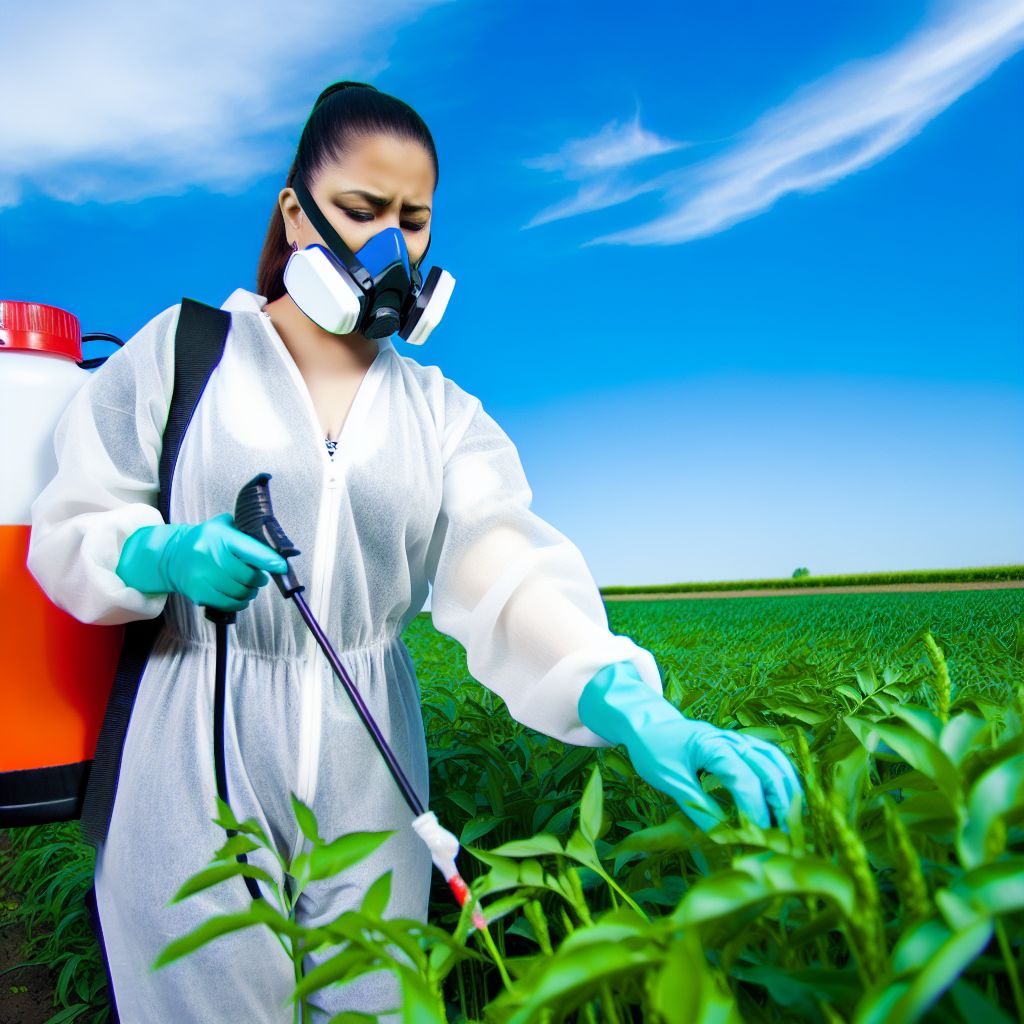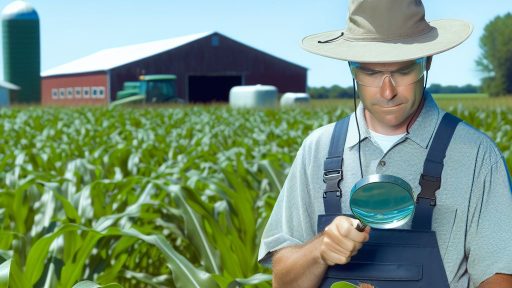Understanding the Different Types of Pesticides and Their Applications
Types of Pesticides
Pesticides can be classified into several categories based on their function.
Insecticides specifically target insect pests.
Herbicides focus on controlling unwanted plants.
Fungicides help manage fungal diseases in crops.
Rodenticides are used to control rodent populations.
Microbicides prevent the growth of harmful microorganisms.
Selective vs. Non-Selective Pesticides
Selectively acting pesticides target specific organisms.
They minimize harm to beneficial species.
Non-selective pesticides affect a wide range of pests.
These can harm beneficial insects and plants.
Application Methods
Pesticides are applied through various methods depending on the target area.
Foliar application involves spraying directly onto plant leaves.
Soil application targets pests residing in the soil.
Trunk injection introduces the pesticide directly into the tree.
Seed treatment protects plants from pests during germination.
Transform Your Agribusiness
Unlock your farm's potential with expert advice tailored to your needs. Get actionable steps that drive real results.
Get StartedTiming of Application
The timing of pesticide application is crucial for effectiveness.
Applying at the right stage of pest development maximizes impact.
Weather conditions also influence when to apply pesticides.
Wind, rain, and temperature can affect application efficacy.
Safety Considerations
Using personal protective equipment is essential during application.
Follow the instructions on the pesticide label carefully.
Ensure that water sources are protected from contamination.
Finally, consider integrating pest management strategies as an alternative.
Importance of Integrated Pest Management (IPM) in Safe Pesticide Use
Understanding Integrated Pest Management
Integrated Pest Management combines different strategies for pest control.
It emphasizes the use of natural predators and ecological methods.
This approach minimizes reliance on chemical pesticides.
Benefits of IPM
IPM promotes safer pesticide usage through informed decision-making.
It reduces environmental impact by using fewer chemicals.
Farmers who adopt IPM can achieve sustainable agriculture.
Additionally, this method helps protect non-target species.
Components of IPM
Monitoring is the first essential aspect of IPM.
Regular inspections identify pest populations and damage levels.
Next, pest identification helps determine the best control methods.
Finally, the integration of multiple control methods ensures effectiveness.
Utilizing Pesticides Responsibly
When pesticides are necessary, follow label directions carefully.
Use the least toxic options available to minimize harm.
Timing application can make a significant difference in effectiveness.
Avoid spraying during windy conditions to prevent drift.
Training and Education
Ongoing education is vital for all pesticide applicators.
Showcase Your Farming Business
Publish your professional farming services profile on our blog for a one-time fee of $200 and reach a dedicated audience of farmers and agribusiness owners.
Publish Your ProfileUnderstanding the principles of IPM enhances safety and efficacy.
Participating in workshops increases knowledge of pest management.
Additionally, proper training reduces the likelihood of misuse.
Choosing the Right Time and Conditions for Pesticide Application
Understanding Weather Conditions
Weather plays a crucial role in pesticide application.
Apply pesticides during optimal weather conditions.
Avoid windy days to prevent drift.
Rainy conditions can wash away the treatment.
Choose dry conditions for maximum effectiveness.
Timing the Application
Timing affects the success of weed and pest control.
Apply pesticides in the early morning or late evening.
These times generally have less wind and evaporation.
Monitor pest activity to optimize application schedules.
Checking Plant Conditions
Inspect plant conditions before application.
Healthy plants absorb pesticides more effectively.
Avoid applying to stressed plants due to drought or disease.
This can reduce the efficacy of the treatment.
Understanding Target Pests
Identify pests before applying pesticides.
Understanding their life cycle helps in better timing.
Apply when pests are most vulnerable.
Adjust your strategy based on the pest species.
Consideration of Local Regulations
Familiarize yourself with local pesticide regulations.
Some areas have restrictions on application times.
Abide by guidelines to ensure environmental safety.
This protects beneficial organisms in the area.
Explore Further: How Farm-To-Table Laws Influence Organic Farming Practices
Proper Equipment Selection and Maintenance for Safe Application
Choosing the Right Equipment
Select appropriate equipment for the specific pesticide being used.
Consider factors like the pesticide’s formulation and application area.
Utilize sprayers that match the pesticide’s viscosity for optimal delivery.
Understand the requirements for personal protective equipment (PPE).
Consult with professionals if you’re unsure about your equipment choices.
Regular Maintenance Practices
Inspect all equipment before use to ensure safe operation.
Clean equipment after each use to avoid cross-contamination.
Replace worn or damaged parts immediately to maintain effectiveness.
Follow the manufacturer’s guidelines for servicing and storage.
Install proper filters in sprayers to prevent clogs and malfunctions.
Calibration of Equipment
Calibrate equipment before each use to ensure precise application rates.
Use water to test spray patterns and adjust nozzles as necessary.
Document calibration settings for future reference and consistency.
Regularly recheck calibrations to account for environmental changes.
Seek assistance from agricultural extension services if needed.
Showcase Your Farming Business
Publish your professional farming services profile on our blog for a one-time fee of $200 and reach a dedicated audience of farmers and agribusiness owners.
Publish Your ProfileImportance of Record-Keeping
Maintain detailed records of equipment maintenance and service history.
Document any repairs or replacements made to improve accountability.
Include records of calibration data to track application accuracy over time.
Use this information to identify trends and areas for improvement.
Share records with your team to promote safety and compliance.
Explore Further: Navigating Chemical Use Compliance On Farms
Personal Protective Equipment (PPE) Guidelines for Pesticide Handlers
Understanding the Importance of PPE
PPE is essential for preventing pesticide exposure.
It helps protect you from skin contact, inhalation, and ingestion.
Using the right PPE reduces health risks during pesticide application.
Choosing the Right PPE
Select PPE based on the type of pesticide and its hazards.
Consult product labels for specific recommendations and requirements.
Key items include gloves, eyewear, and protective clothing.
Gloves
Wear chemical-resistant gloves made of suitable materials.
Ensure that gloves fit properly for optimal protection.
Inspect gloves for tears or wear before each use.
Eye Protection
Use goggles or face shields to protect your eyes from splashes.
Ensure goggles have a snug fit to prevent chemical exposure.
Contact lenses are not recommended during pesticide handling.
Protective Clothing
Wear long-sleeved shirts and pants to minimize skin exposure.
Choose fabrics that are tightly woven and chemical-resistant.
Consider wearing coveralls for additional protection.
Ensuring Proper Use of PPE
Always wear PPE when mixing, loading, or applying pesticides.
Check the fit and condition of PPE before starting work.
Keep an extra set of PPE available in case of contamination.
Maintaining and Cleaning PPE
Properly clean and store PPE after each use.
Follow manufacturer instructions for washing and drying PPE.
Regularly inspect PPE for signs of damage or wear.
Gain More Insights: Climate Change Policies Affecting Agriculture

Reading and Interpreting Pesticide Labels for Safe Use
Understanding Pesticide Labels
Reading pesticide labels is essential for safe application.
Pesticide labels provide vital information about the product.
They include instructions for use, safety precautions, and legality.
Understanding these details ensures effective pest control.
Additionally, labels help prevent environmental harm.
Key Components of Pesticide Labels
Active ingredients are clearly listed on the label.
The label states the intended use of the pesticide.
Dosage instructions indicate how much product to use.
Safety information explains necessary precautions.
Signal words describe the toxicity level of the product.
Reading the Directions
Follow the directions for application closely.
Timing and frequency of application impact effectiveness.
Showcase Your Farming Business
Publish your professional farming services profile on our blog for a one-time fee of $200 and reach a dedicated audience of farmers and agribusiness owners.
Publish Your ProfileUnderstand re-entry intervals after applying pesticides.
This information protects both the applicator and others.
Understanding Safety Precautions
Always wear appropriate protective gear when applying pesticides.
This gear typically includes gloves, masks, and goggles.
Avoid eating or drinking during application to reduce risks.
Additionally, ensure proper ventilation in enclosed spaces.
Storing Pesticides Safely
Store pesticides in a cool, dry place away from children.
Ensure containers are tightly sealed and labeled clearly.
Consider local regulations regarding pesticide storage.
Improper storage can lead to accidental exposure.
Environmental Considerations
Always consider the impact of pesticides on the environment.
Be aware of sensitive areas like water sources and wildlife habitats.
Follow guidelines to minimize runoff and contamination.
Use integrated pest management strategies when possible.
Uncover the Details: Technological Innovations In Conservation Programs For Farming
Environmental Considerations
Minimizing Impact on Non-target Species
Every pesticide application carries potential risks to non-target species.
To minimize these risks, consider the surrounding ecosystem.
First, choose pesticides that are specifically designed to target unwanted pests.
This ensures a reduced chance of affecting beneficial organisms.
Second, timing your application can significantly influence outcomes.
Apply pesticides during periods when non-target species are less active.
For example, late evenings or early mornings are often ideal.
Furthermore, always check weather conditions before application.
Avoid applying pesticides during windy or rainy days.
Wind can carry particles to unintended areas, impacting sensitive habitats.
Rain can wash away pesticides, leading to runoff into nearby water sources.
Next, physical barriers can help protect vulnerable species.
Using buffer zones around sensitive areas can prevent exposure.
For instance, plant native vegetation that can act as a barrier.
This strategy not only protects non-target species but boosts biodiversity.
Regular Monitoring and Assessment
Continuous monitoring of pesticide impacts is vital.
Implement a schedule for regular assessments of local wildlife and plants.
If populations decline or show signs of stress, investigate the causes.
Adjust your pesticide use accordingly to mitigate adverse effects.
Educating personnel on the importance of non-target species is crucial.
Provide training sessions focusing on best practices in pesticide application.
Ensuring everyone is aware of their impact fosters a culture of responsibility.
Seeking Alternatives
Consider integrating non-chemical pest control methods into your strategy.
Biological controls, like introducing natural predators, offer sustainable solutions.
Cultural practices, such as crop rotation, can also manage pest populations.
Showcase Your Farming Business
Publish your professional farming services profile on our blog for a one-time fee of $200 and reach a dedicated audience of farmers and agribusiness owners.
Publish Your ProfileUtilizing integrated pest management (IPM) approaches can be highly effective.
This method combines biological, cultural, and chemical controls thoughtfully.
Ultimately, find a balance that minimizes harm while effectively managing pests.
Incorporating various strategies leads to healthier ecosystems and safer communities.
Emergency Procedures and First Aid for Pesticide Exposure
Immediate Actions
In case of pesticide exposure, take immediate action.
Quickly assess the situation and identify the pesticide involved.
If safe, remove the affected person from the exposure area.
Ensure that the person is in a well-ventilated space.
Remove contaminated clothing carefully to avoid further exposure.
Skin Exposure
If pesticide contacts the skin, wash it off immediately.
Use soap and plenty of water for at least 15 minutes.
Inspect the skin for irritation or burns after washing.
Seek medical attention if the irritation persists.
Eye Exposure
In the event of eye contact, rinse eyes with water or saline.
Continue rinsing for at least 15 minutes.
Avoid rubbing the eyes, as this can worsen the irritation.
Seek medical help if symptoms do not improve.
Inhalation
If someone breathes in pesticide fumes, move them to fresh air immediately.
Loosen any tight clothing and have them sit down.
Monitor their breathing and provide reassurance.
Call for medical help if they experience severe symptoms.
Ingestion
If a pesticide is swallowed, do not induce vomiting.
Call poison control or emergency services right away.
Provide them with information on the pesticide if possible.
Reporting Exposure
After addressing immediate concerns, report the incident.
Document all details of the exposure for future reference.
Ensure that proper procedures are followed in reporting.
Notify supervisors and health and safety officers as needed.
First Aid Supplies
Keep an accessible first aid kit for pesticide exposure incidents.
The kit should contain safety goggles, gloves, and soap.
Include activated charcoal for ingestion incidents, if advised.
Regularly check and replenish supplies in the kit.




